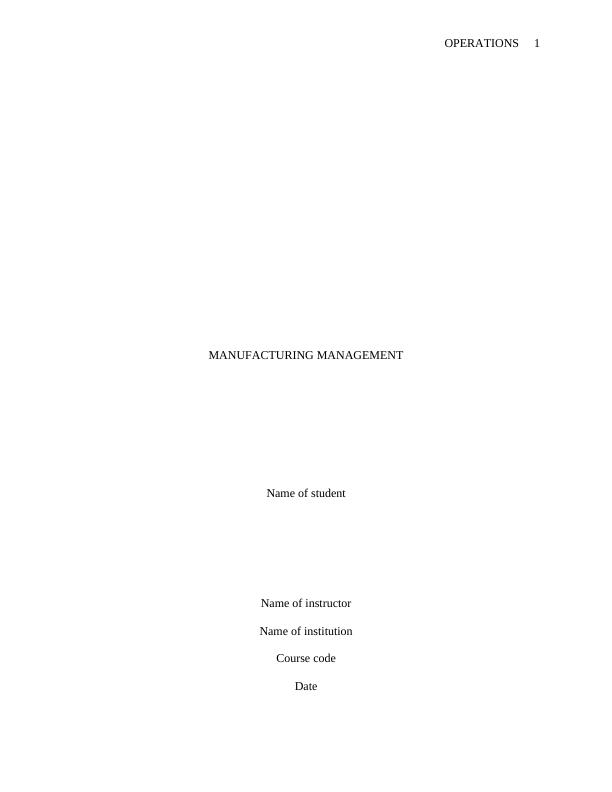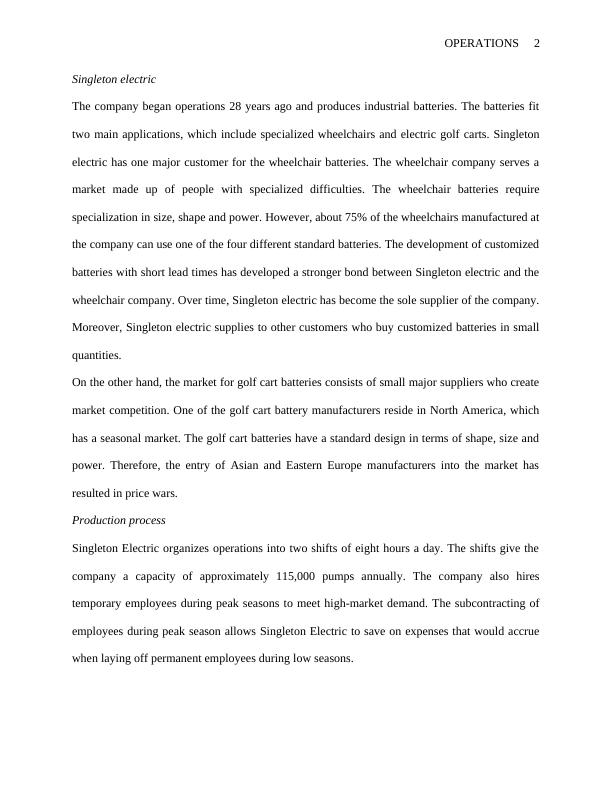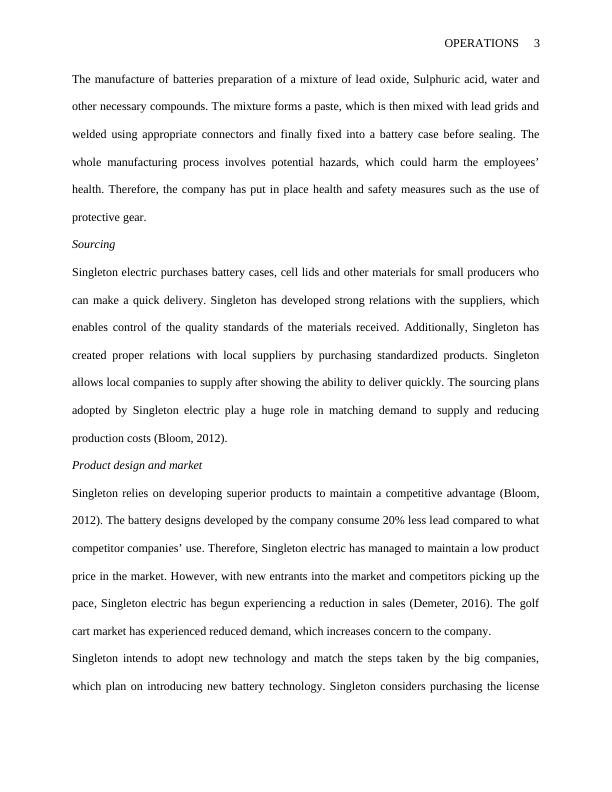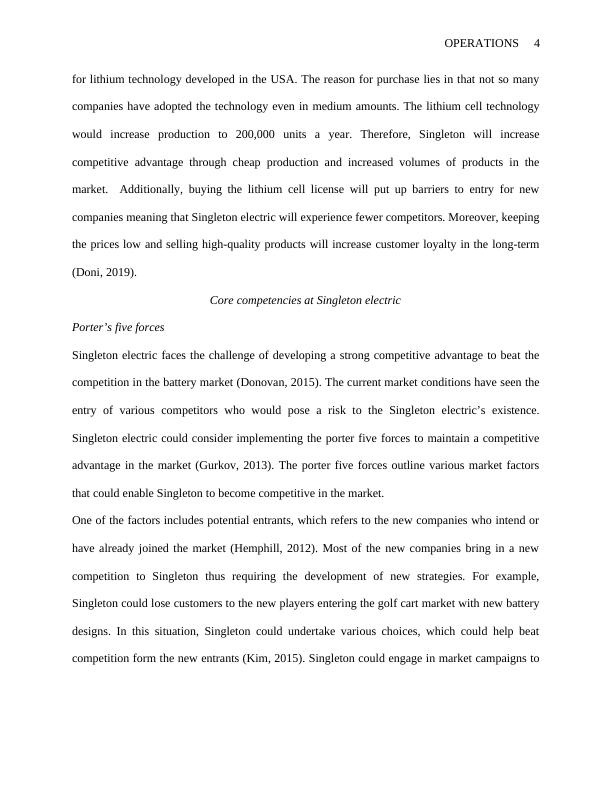Operations in Manufacturing Management
Added on 2023-04-20
20 Pages5533 Words173 Views
OPERATIONS 1
MANUFACTURING MANAGEMENT
Name of student
Name of instructor
Name of institution
Course code
Date
MANUFACTURING MANAGEMENT
Name of student
Name of instructor
Name of institution
Course code
Date

OPERATIONS 2
Singleton electric
The company began operations 28 years ago and produces industrial batteries. The batteries fit
two main applications, which include specialized wheelchairs and electric golf carts. Singleton
electric has one major customer for the wheelchair batteries. The wheelchair company serves a
market made up of people with specialized difficulties. The wheelchair batteries require
specialization in size, shape and power. However, about 75% of the wheelchairs manufactured at
the company can use one of the four different standard batteries. The development of customized
batteries with short lead times has developed a stronger bond between Singleton electric and the
wheelchair company. Over time, Singleton electric has become the sole supplier of the company.
Moreover, Singleton electric supplies to other customers who buy customized batteries in small
quantities.
On the other hand, the market for golf cart batteries consists of small major suppliers who create
market competition. One of the golf cart battery manufacturers reside in North America, which
has a seasonal market. The golf cart batteries have a standard design in terms of shape, size and
power. Therefore, the entry of Asian and Eastern Europe manufacturers into the market has
resulted in price wars.
Production process
Singleton Electric organizes operations into two shifts of eight hours a day. The shifts give the
company a capacity of approximately 115,000 pumps annually. The company also hires
temporary employees during peak seasons to meet high-market demand. The subcontracting of
employees during peak season allows Singleton Electric to save on expenses that would accrue
when laying off permanent employees during low seasons.
Singleton electric
The company began operations 28 years ago and produces industrial batteries. The batteries fit
two main applications, which include specialized wheelchairs and electric golf carts. Singleton
electric has one major customer for the wheelchair batteries. The wheelchair company serves a
market made up of people with specialized difficulties. The wheelchair batteries require
specialization in size, shape and power. However, about 75% of the wheelchairs manufactured at
the company can use one of the four different standard batteries. The development of customized
batteries with short lead times has developed a stronger bond between Singleton electric and the
wheelchair company. Over time, Singleton electric has become the sole supplier of the company.
Moreover, Singleton electric supplies to other customers who buy customized batteries in small
quantities.
On the other hand, the market for golf cart batteries consists of small major suppliers who create
market competition. One of the golf cart battery manufacturers reside in North America, which
has a seasonal market. The golf cart batteries have a standard design in terms of shape, size and
power. Therefore, the entry of Asian and Eastern Europe manufacturers into the market has
resulted in price wars.
Production process
Singleton Electric organizes operations into two shifts of eight hours a day. The shifts give the
company a capacity of approximately 115,000 pumps annually. The company also hires
temporary employees during peak seasons to meet high-market demand. The subcontracting of
employees during peak season allows Singleton Electric to save on expenses that would accrue
when laying off permanent employees during low seasons.

OPERATIONS 3
The manufacture of batteries preparation of a mixture of lead oxide, Sulphuric acid, water and
other necessary compounds. The mixture forms a paste, which is then mixed with lead grids and
welded using appropriate connectors and finally fixed into a battery case before sealing. The
whole manufacturing process involves potential hazards, which could harm the employees’
health. Therefore, the company has put in place health and safety measures such as the use of
protective gear.
Sourcing
Singleton electric purchases battery cases, cell lids and other materials for small producers who
can make a quick delivery. Singleton has developed strong relations with the suppliers, which
enables control of the quality standards of the materials received. Additionally, Singleton has
created proper relations with local suppliers by purchasing standardized products. Singleton
allows local companies to supply after showing the ability to deliver quickly. The sourcing plans
adopted by Singleton electric play a huge role in matching demand to supply and reducing
production costs (Bloom, 2012).
Product design and market
Singleton relies on developing superior products to maintain a competitive advantage (Bloom,
2012). The battery designs developed by the company consume 20% less lead compared to what
competitor companies’ use. Therefore, Singleton electric has managed to maintain a low product
price in the market. However, with new entrants into the market and competitors picking up the
pace, Singleton electric has begun experiencing a reduction in sales (Demeter, 2016). The golf
cart market has experienced reduced demand, which increases concern to the company.
Singleton intends to adopt new technology and match the steps taken by the big companies,
which plan on introducing new battery technology. Singleton considers purchasing the license
The manufacture of batteries preparation of a mixture of lead oxide, Sulphuric acid, water and
other necessary compounds. The mixture forms a paste, which is then mixed with lead grids and
welded using appropriate connectors and finally fixed into a battery case before sealing. The
whole manufacturing process involves potential hazards, which could harm the employees’
health. Therefore, the company has put in place health and safety measures such as the use of
protective gear.
Sourcing
Singleton electric purchases battery cases, cell lids and other materials for small producers who
can make a quick delivery. Singleton has developed strong relations with the suppliers, which
enables control of the quality standards of the materials received. Additionally, Singleton has
created proper relations with local suppliers by purchasing standardized products. Singleton
allows local companies to supply after showing the ability to deliver quickly. The sourcing plans
adopted by Singleton electric play a huge role in matching demand to supply and reducing
production costs (Bloom, 2012).
Product design and market
Singleton relies on developing superior products to maintain a competitive advantage (Bloom,
2012). The battery designs developed by the company consume 20% less lead compared to what
competitor companies’ use. Therefore, Singleton electric has managed to maintain a low product
price in the market. However, with new entrants into the market and competitors picking up the
pace, Singleton electric has begun experiencing a reduction in sales (Demeter, 2016). The golf
cart market has experienced reduced demand, which increases concern to the company.
Singleton intends to adopt new technology and match the steps taken by the big companies,
which plan on introducing new battery technology. Singleton considers purchasing the license

OPERATIONS 4
for lithium technology developed in the USA. The reason for purchase lies in that not so many
companies have adopted the technology even in medium amounts. The lithium cell technology
would increase production to 200,000 units a year. Therefore, Singleton will increase
competitive advantage through cheap production and increased volumes of products in the
market. Additionally, buying the lithium cell license will put up barriers to entry for new
companies meaning that Singleton electric will experience fewer competitors. Moreover, keeping
the prices low and selling high-quality products will increase customer loyalty in the long-term
(Doni, 2019).
Core competencies at Singleton electric
Porter’s five forces
Singleton electric faces the challenge of developing a strong competitive advantage to beat the
competition in the battery market (Donovan, 2015). The current market conditions have seen the
entry of various competitors who would pose a risk to the Singleton electric’s existence.
Singleton electric could consider implementing the porter five forces to maintain a competitive
advantage in the market (Gurkov, 2013). The porter five forces outline various market factors
that could enable Singleton to become competitive in the market.
One of the factors includes potential entrants, which refers to the new companies who intend or
have already joined the market (Hemphill, 2012). Most of the new companies bring in a new
competition to Singleton thus requiring the development of new strategies. For example,
Singleton could lose customers to the new players entering the golf cart market with new battery
designs. In this situation, Singleton could undertake various choices, which could help beat
competition form the new entrants (Kim, 2015). Singleton could engage in market campaigns to
for lithium technology developed in the USA. The reason for purchase lies in that not so many
companies have adopted the technology even in medium amounts. The lithium cell technology
would increase production to 200,000 units a year. Therefore, Singleton will increase
competitive advantage through cheap production and increased volumes of products in the
market. Additionally, buying the lithium cell license will put up barriers to entry for new
companies meaning that Singleton electric will experience fewer competitors. Moreover, keeping
the prices low and selling high-quality products will increase customer loyalty in the long-term
(Doni, 2019).
Core competencies at Singleton electric
Porter’s five forces
Singleton electric faces the challenge of developing a strong competitive advantage to beat the
competition in the battery market (Donovan, 2015). The current market conditions have seen the
entry of various competitors who would pose a risk to the Singleton electric’s existence.
Singleton electric could consider implementing the porter five forces to maintain a competitive
advantage in the market (Gurkov, 2013). The porter five forces outline various market factors
that could enable Singleton to become competitive in the market.
One of the factors includes potential entrants, which refers to the new companies who intend or
have already joined the market (Hemphill, 2012). Most of the new companies bring in a new
competition to Singleton thus requiring the development of new strategies. For example,
Singleton could lose customers to the new players entering the golf cart market with new battery
designs. In this situation, Singleton could undertake various choices, which could help beat
competition form the new entrants (Kim, 2015). Singleton could engage in market campaigns to

End of preview
Want to access all the pages? Upload your documents or become a member.
Related Documents
Singleton’s Management Strategy Assignmentlg...
|9
|2435
|116
The material cost of lead sheetslg...
|21
|5055
|20
TESLA TESLA 6 Tesla Name of the university: An Introductionlg...
|8
|1732
|404
Advanced Principles in Supply Chain Managementlg...
|9
|1859
|451
Tesla's Seven Strategic Decision Areas for Optimal Productionlg...
|2
|593
|463
Analysis of Tesla's Firm Business Environmentlg...
|6
|1301
|34
